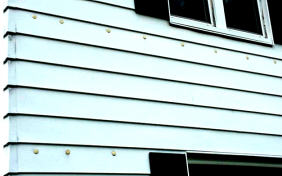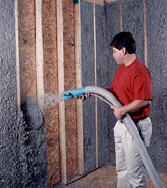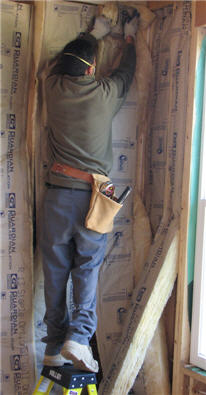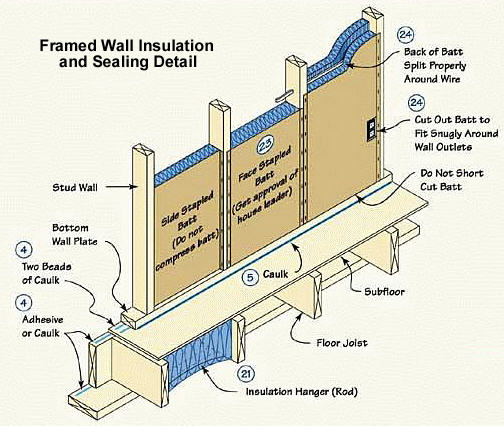Wall Insulation
Overview
See The Structure
When and Where To Insulate
 Retrofit
Retrofit
Houses built before about 1965 (varies with region) were built without wall insulation. If it is not obvious whether insulation exists or not – ie : past remodel jobs that opened wall cavities, plugs in exterior siding, insulation that has leaked into the basement, it is generally pretty easy to determine if wall insulation exists:
- remove a switch or outlet cover on an exterior wall; look into or probe the wall with a wire – be sure probe only the OUTSIDE of the box or turn off the power before probing through the box
- from the basement, look or probe exterior walls around plumbing and wiring penetrations of the sill plate
How WELL the walls are insulated is a completely different story. It is virtually impossible to evaluate the effectiveness of concealed wall insulation. Even thermal scans can be deceptive. Therefore, the main question is: Wall Insulation or NO Wall Insulation.
If there is NO wall insulation, it needs to be added. If there IS wall insulation, there’s nothing more that can be done short of a major renovation that removes one side of the wall covering.
 New Construction
New Construction
The construction method will determine the maximum potential insulation, and the quality of construction will determine how well the insulation performs.
All exterior walls and walls that face unconditioned spaces such as garages and attics, must be insulated in the cavity. Standard residential construction is 2×4 stud, which has a 3 ½ ” cavity for insulation of R-11 to R-13. More energy efficient houses will have 2×6 stud walls with a 5 ½ ” cavity, allowing more room for insulation. It does no good to compress extra insulation into the space. For example, a 5 ½ ” battgives no more R-value in a 3 ½ ” wall cavity than the 3 ½ ” batt and costs more to purchase.
The inside of the wall should be covered with a vapor barrier and the outside of the wall sheathed with a foam board for best insulation performance. (I do not consider the kraft paper on rolled insulation products to be an adequate vapor barrier because it has too many voids when installed according to conventional construction practices.)
In high temperature and moisture areas, such as the gulf-coast, vapor barriers are not recommended unless installed on the outside of the wall.
See Vapor Barriers
Insulation Options
Retrofit
- blow-in cellulose
- blow-in fiberglass
- pour/spray-in Spray Foam
New Construction
- rolled fiberglass
- spray-in cellulose
- spray-in fiberglass
- spray-in Spray Foam
More Information

Open a PDF document from DOE on Wall Insulation
Web sites and sources of information used on this page
Cellulose
Applegate Insulation at www.applegateinsulation.com
Fiberglass
Open wall blowing Guardian Fiberglass at www.guardianfiberglass.com search products for Ultrafit

Open wall rolls Owens Corning at www.owenscorning.com /around/insulation/project/ exteriorwalls.asp
Notes: Spray-in foam insulations containing formaldehyde were popular in the late 1970’s and early 1980’s. They fell from favor when some home owners had bad reactions to the high levels of formaldehyde released as the foams cured. Most of the problems were traced to improper mixing and installation by inexperience installers, but the bad press killed the industry anyway. From an energy standpoint, the problem was that the foam also shrank while it cured. It would then pull away from the wall surfaces leaving large air gaps and un-insulated spaces.
For information about a new spray-in foam see Spray Foam
Sources: Text Bob Fegan 12/2008; images and product info from: cellulose Applegate Insulation www.applegateinsulation.com 8/2003; open wall fiberglass blowing from Guardian Industries at www.guardianfiberglass.com /products/ ultrafit.htm ; fiberglass rolls from Owens Corning atwww.owenscorning.com /around/insulation/project/ exteriorwalls.asp; other photos by Bob Fegan
© 2008 Energy Solutions Center400 N. Capitol Street NWWashington, DC 20001 All rights reserved. Legal Contact our webmaster
